Magic: The Gathering has five different types of permanents. There are creatures, enchantments, lands, planeswalkers, and artifacts. Today we will discuss all things artifacts. They are, after all, an important part of the MTG; Not only are they often powerful from a gameplay perspective but they are also very important to Magic: The Gathering lore. With that said, there is a ton to break down here, so let’s start with what an artifact is.
They are permanents that represent magical items, animated machinery, pieces of equipment that can be worn, or other objects and devices imbued with magic. There are several different sub-categories: For example, there are artifacts that are also creatures and others that are lands. For the most part, they are “colorless” but there are exceptions to this.
They are one of the most diverse permanent types. This diversity means there are tons of different ways to use them in-game. Below, we’ll go over each artifact type, how it works, and then look at the very best ones the game has to offer.
Table Of Contents:
- What Are Artifacts?
- How Do They Work?
- Frequently Asked Question
- Different Types Of Artifacts
- How To Beat Them
- Deck Lists
- Best Cards
What Are Artifacts?
They are permanents that usually represent magical items, animated machinery, pieces of equipment that can be worn, or other objects and devices imbued with magic. There are several different sub-categories – Such as creatures, lands, and tokens.
They also have an extremely diverse range of effects and abilities. As an example, there are aggressive abilities likeShrine of Burning Rage, controlling ones like Ensnaring Bridge, mana-producers like Talisman of Dominance, and nearly everything in between.
For the most part, artifacts are “colorless” but there are exceptions to this. Cards such as Embercleave and The Great Henge are great examples of some powerful ones that are colored.
Historic Spells
“Historic” is a term first introduced in Dominaria. The term collectively refers to artifacts, any spell with the legendary supertype, and Sagas. So, in addition to everything mentioned above all artifacts are Historic spells.
This means that any spell referencing historic spells is referring to artifacts as well. As an example, the card Jhoira’s Familiar can tutor out artifacts.
How Do They Work Work?
Artifacts have a wide variety of effects and can do lots of different things. With that said, let’s start with the basics. They are cast the same as other nonland permanents.
This means their casting cost is paid, they go onto the stack, and then resolve if nothing stops them from doing so. Once you’ve successfully resolved your artifact it enters the battlefield and can be used in whatever way the card says.
With that out of the way, let’s answer some frequently asked questions.
Frequently Asked Questions
Do Artifacts Have Summoning Sickness?
This question comes up quite a bit amongst newer players. The answer is, that it depends. Non-creature artifacts don’t have summoning sickness. This means you can tap things like Expedition Map and Tormod’s Crypt the first turn you play them.
However, artifact creatures do have summoning sickness unless they have haste. So, for example, a Steel Overseer couldn’t attack or tap to use its ability on the turn it entered the battlefield.
Are Artifacts Monocolored?
The answer here is usually, no. Most are “colorless”, which means they aren’t colored at all and therefore, they can’t be mono-colored. However, there are some that do have colored mana symbols and as long as they were a single color, they would be mono-colored.

Related: The MTG Color Wheel
Here are some examples – Pentad Prism is colorless. While cards such as Midnight Clock are mono-colored. Lastly, there are some, such as Demonspine Whip that are multicolored.
Can Legendary Artifacts Be Commanders?
Again, the answer here is yes and no. Let me elaborate. Legendary artifacts that are also creatures can be your commander. However, ones that aren’t creatures cannot be commanders, even if they are Legendary.
Take the card Breya, Etherium Shaper as an example. The card is a perfectly legal commander since it is legendary and a creature. However, it is legal because it is an artifact in addition to meeting those other requisites.
With that said, a card like Aetherworks Marvel couldn’t be a commander for an EDH deck. There is, however, a pseudo-exception to this and that is the dual-faced cards from Kaldheim.

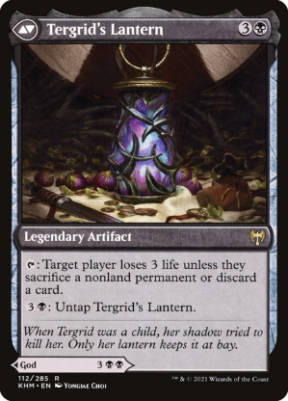
Cards such as Tergrid, God of Fright have an artifact that you can choose to cast from your command zone. But even still, this is only because it comes as a bonus with a creature that is a legal commander.
So, to summarize, legendary artifact creatures can be your commander. Ones that are not creatures (legendary or otherwise) cannot.
Can You Have Two Of The Same Legendary Artifact?
No, you can’t. Players can only control one legendary permanent (including artifact) with the same name at the same time. This is known as the “legend rule” and is in place to balance the often powerful effects of legendary permanents.
Here is a look at the official wording of the legend rule:
If two or more legendary permanents with the same name are controlled by the same player, that player chooses one of them, and the rest are put into their owners’ graveyards. This is called the “legend rule.”
The Comprehensive Rules 704.5j
As an example, let’s say you had a Thalia, Guardian of Thraben on the field and you cast a second copy of the card. Assuming it resolved, it would enter the battlefield, and then you’d have to choose one copy to keep and sacrifice the other.
With that said, there are very few cards in MTG that circumvent the legend rule. Here’s a look at them if you’re interested.
| Cards | Effect |
| Mirror Gallery, Mirror Box and Sakashima of a Thousand Faces | Cancels the rule altogether |
| Brothers Yamazaki | Allows you to control exactly two copies of the card |
| Aeve, Progenitor Ooze, Jace, Cunning Castaway, Jace, Mirror Mage, and Ob Nixilis, the Adversary | Makes copies of themselves that aren’t legendary |
| Delina, Wild Mage, Double Major, Echoing Equation, Helm of the Host, Irenicus’s Vile Duplication, Miirym, Sentinel Wyrm and Spark Double | Makes copies of other permanents that aren’t legendary |
| Sakashima the Impostor, Olag, Ludevic’s Hubris, Lazav, Dimir Mastermind and Lazav, the Multifarious | Can copy other legendary creatures |
Different Types Of Artifacts
There are quite a few different subtypes of artifacts. As well as things (such as land) that have an artifact subtype attached to them. In this section, we’ll break down each of the different types you may encounter.
Equipment

An equipment is an artifact with the “equip” keyword ability. By paying the equip cost, it attaches to a creature you control. The creature then gets the benefit stated on the equipment until it is removed. If that creature leaves play, the Equipment becomes unattached and remains in play.
Equipment(s) are a very powerful artifact type. There are a few things that make them quite good. First, they do have the artifact card type. This means they have high synergy with “artifact matter cards” like Alela, Artful Provocateur.
Secondly, if the creature the equipment is attached to happens to die the equipment stays behind. This gives you a huge advantage over things like Auras that die with the creature when they go.
Creatures
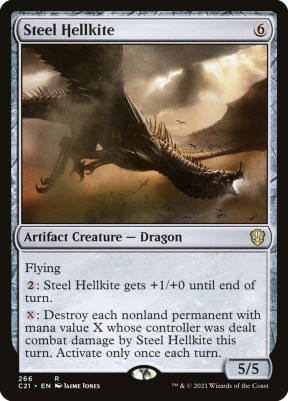
Artifact creatures behave just like other creatures do. They can attack and block, be destroyed by creature removal (and artifact removal for that matter), and deal combat damage like any other creature. Functionally, they are just like other creatures. This includes having summoning sickness.
So, are there any differences? First, artifact creatures usually don’t have the best stat-to-mana cost ratio. This is because a) Having the artifact subtype can be a big upside and b) since they don’t require colored mana to cast they can go in any/all decks.
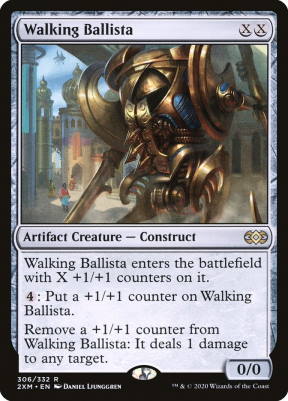
Second, anything that references the card type obviously affects them as well. So for example, Unwinding Clock could untap all your creatures as well if they happen to be artifact creatures. Synergies such as this can be extremely powerful when built around things like Steel Overseer.
With that said, there are downsides as well. For example, a somewhat narrow card like Shattering Spree will suddenly have tons of targets if a player has tons of artifact creatures.
Lands
Like the creatures mentioned above, artifact lands work just like any other land and any other artifact in MTG. So, they enter the battlefield without being cast and tap for their designated color(s) of mana without ever using the stack.
These lands are one of the most subtle bonuses for decks that care about the card type. Since it comes tacked onto something you’d play anyways, they can offer tons of upside without much downside. For example, things such as Mox Opal and other cards with “Metalcraft” or cards like Thoughtcast love being able to have extra artifacts on the field via their lands.
Here is a list of all artifact lands.
- Ancient Den
- Darkmoss Bridge
- Darksteel Citadel
- Drossforge Bridge
- Goldmire Bridge
- Great Furnace
- Mistvault Bridge
- Power Depot
- Razortide Bridge
- Rustvale Bridge
- Seat of the Synod
- Silverbluff Bridge
- Slagwoods Bridge
- Tanglepool Bridge
- Thornglint Bridge
- Treasure Vault
- Tree of Tales
- Vault of Whispers
Mana Rocks
Mana rocks aren’t actually a separate type of artifact. However, they are a slang term for a specific group of artifacts that all do the same thing; and that is, tap for mana. To be clear, they aren’t lands like the cards listed above.
Overall, “mana rocks” refer to any non-creature artifact that produces mana. They have two main purposes: First, to “ramp” a player by giving them access to more mana than they would have by simply playing a land each turn.
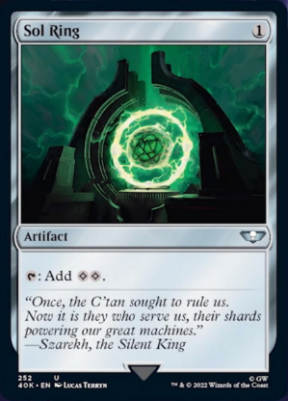
The second is to “fix” mana colors. This refers to using mana rocks to turn mana from one color to another. Mana Cylix is a good example of this.
While different mana rocks are legal and present in nearly every format they are by far the most common in commander. Here are some examples of popular mana rocks.
- Sol Ring
- Arcane Signet
- Thought Vessel
- Mind Stone
- Ancient Tomb
- Orzhov Signet
- Fire Diamond
- Commander’s Sphere
- Darksteel Ingot
- Mana Geode
- Manalith
- Powerstone Shard
Tokens
There are quite a few artifact tokens that can be created by different means. For example, Strike it Rich creates treasure tokens, Tireless Tracker makes clue tokens, King Macar, the Gold-Cursed makes gold tokens, and Gilded Goose makes food tokens.
There are tons more cards that can make each of these tokens as well. These tokens can help accelerate artifact strategies quite a bit in addition to their primary function. Furthermore, creating mass amounts of these tokens can even be a way to win the game with things like Revel in Riches or Hellkite Tyrant.
How To Beat Them
You’ll find decks with a few utility artifacts peppered in. Maybe Shrine of Burning Rage in a burn deck or Lotus Bloom in a deck trying to accelerate toward its game-winning combo and you’ll also find full decks built around the card type. Either way, you’ll want to be able to answer them. So how do you do so?
With removal, interaction, and hate cards of course. It’s note-worthy that Black and Blue as colors have the hardest time answering the card type directly, while Red, Green, and White excel at it. Here are some great removal spells and hate cards in the colors that have them and some options for those that don’t.
Deck Lists
Commander / EDH
Commander is the most popular MTG format, so let’s start here. First off, even if a deck is not themed around them, you’d be hard-pressed to find a commander deck without artifacts. Almost all decks, run at least a few, and most decks run quite a bit.
This is why cards like Dockside Extortionist are such powerhouses. For the record, I’ve personally seen Dockside Extortionist create up to 19 treasures upon being cast. If he combos of it gets even crazier!
That said, strategies built particularly around the card type are some of the most popular archetypes for commander and many are very powerful. However, there are way too many to list here; so instead let’s look at some of the very best commanders for the archetype as opposed to specific deck lists. Here are some of the top-played commanders and how they play.
| Commander | Play Style / Possible Themes |
| Breya, Etherium Shaper | Sacrifice, Vehicles, Thopters, Treasures |
| Osgir, the Reconstructor | Aggro, Sacrifice, Copies |
| Traxos, Scourge of Kroog | Historic spells, Equipment |
| Urza, Lord High Artificer | Combo/Storm |
| Jhoira, Weatherlight Captain | Storm, Cheerios, Historic spells |
| Alibou, Ancient Witness | Aggro |
| Oswald Fiddlebender | Toolbox, combo |
| Meria, Scholar of Antiquity | Ramp, Exile, Storm |
| Daretti, Scrap Savant | Sacrifice, Reanimation |
| Saheeli, the Gifted | Tokens, Treasures |
You can find more on all these commanders and many more on EDHREC, here.
Modern
Again, there are several viable ways to build artifact-based strategies in Modern as well. I’ve chosen my personal favorite and a new take on an old classic to showcase today.
Puresteel Paladin Equipments
| Creature (20) 4 Puresteel Paladin 3 Auriok Steelshaper 4 Kor Duelist 1 Sram, Senior Edificer 1 Etched Champion 4 Giver of Runes 3 Stoneforge Mystic Artifact (20) 3 Bonesplitter 4 Flayer Husk 4 Silver-Inlaid Dagger 4 Colossus Hammer 1 Paradise Mantle 1 Accorder’s Shield 2 Bone Saw 1 Spidersilk Net Instant (2) 2 Dispatch Land (18) 14 Plains 4 Sunbaked Canyon |
The deck is built around low-costed (or free) equipment and the abilities of Puresteel Paladin and Sram, Senior Edificer. Once either one of these key creatures is on the battlefield (and hopefully protected by Giver of Runes) you can cast multiple equipment spells, draw cards, and hopefully cast even more.
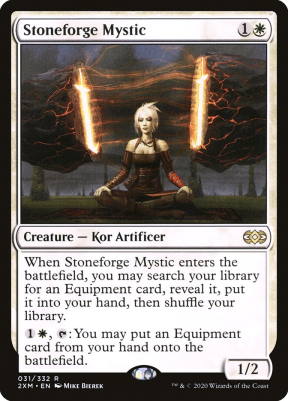
Puresteel Paladin also allows you to attach them all for free – This means that cards like Silver-Inlaid Dagger, Colossus Hammer, and Bonesplitter can quickly turn him or Kor Duelist into threats that can end the game with a single swing.
Modern Affinity
| Artifact (14) 4 Cranial Plating 1 Shadowspear 1 Pithing Needle 1 Relic of Progenitus 4 Springleaf Drum 1 Aether Spellbomb 1 Nettlecyst 1 Welding Jar Creature (24) 4 Memnite 4 Ornithopter 4 Frogmite 4 Thought Monitor 4 Patchwork Automaton 4 Sojourner’s Companion Sorcery (4) 4 Thoughtcast Land (18) 4 Urza’s Saga 4 Darksteel Citadel 2 Treasure Vault 2 Island 4 Mistvault Bridge 1 Otawara, Soaring City 1 Underground River |
This one is built around the classic “Affinity” mechanic. The deck wants to get a high number of artifacts onto the battlefield quickly with creatures like Memnite and Ornithopter and lands with the subtype like, Darksteel Citadel, Treasure vualt, and Mistvualt Bridge.
Once this is achieved, it can power out cards like Sojourner’s Companion, Frogmite, Patchwork Automaton, Thought Monitor, and Thoughtcast. Then pump them into massive threats with Cranial Plating.
There is quite a bit of tech in the deck as well. Things like Springleaf Drum and Welding Jar not only help with Affinity but also offer the deck some acceleration and protection. While Urza’s Sage allows you to toolbox for some spicy one-of answers like, Pithing Needle and Relic of Progenitus.
If you’ve ever played with or against the deck you’ll know just how fast the deck can be.
Best Cards
So, we’ve covered what they are, what they do, how they work, and what the different types there are. With all of that out of the way, let’s look at some of the very best ones and what makes them so great. Let’s just right in.
Note: The list is in no particular order and there are far too many amazing artifacts to list all in one place. So, there will be lots of great cards that don’t show up here.
Sol Ring

Sol Ring is by and large the best mana rock in the game. It’s so powerful that it’s banned in Legacy, restricted in Vintage, and played in nearly every EDH imaginable. What makes it so good? Well, for a single mana you get a card that gives you two mana.
It turns out that netting one extra mana is incredibly good. If you drop a Sol Ring on turn one you can immediately tap it and cast a two drop. Then, on each subsequent turn, you’ll have two extra mana. Dropping an early game Sol Ring is incredibly powerful and means that you’ll be well ahead of the competition early.
Recommended Formats: Commander, Vintage
Engineered Explosives

Engineered Explosives shines in a few key places. First, is formats like Modern, where decks play tons of low CMC spells. In metas running rampant with spells like Ragavan, Nimble Pilferer, Goblin Guide, Death’s Shadow and Amulet of Vigor EE can come down and do a lot of damage for very cheap.
Another huge upside for the card is its “x” casting cost and the fact that creature tokens have a CMC of zero. This means that you can cast EE for zero mana, crack it for two mana and wipe out any and all tokens in play. This is a huge bomb against many decks and that is why it’s a staple of Modern at the moment.
Recommended Formats: Modern
Lightning Greaves
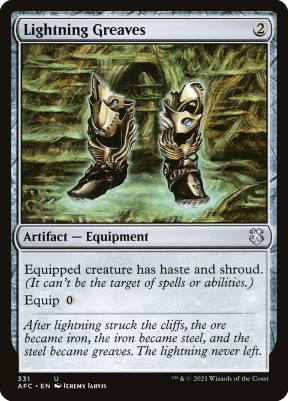
Lightning Greaves is a commander staple and there is a very good reason why. Your two mana gets you two very powerful abilities – Haste and shroud. On top of that, it costs nothing to attach it to your creatures. This gives you two huge upsides.
First, it will always be able to be attached the turn you play it. Secondly, you can switch it between creatures as needed without needing to have extra mana. This makes the greaves a valuable asset to decks that want to attack early and/or protect their commanders at all costs.
The speed and protection that lightning greaves offer nearly any deck are unrivaled and it’s truly one of the best equipment in the game.
Recommended Formats: Commander
Chalice of the Void
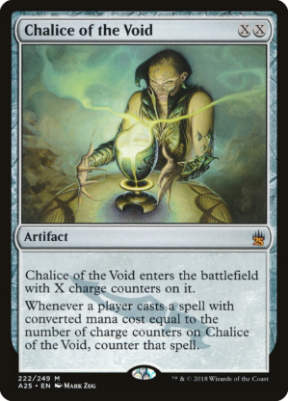
Chalice of the Void is a powerhouse of an artifact in metas where the average CMC of the spells is very low. For just a few mana, the card is capable of single-handedly shutting off very large portions of opposing decks.
For as little as two mana this can be very oppressive by cutting off a huge number of powerful, commonly played spells. For example, in Modern many decks play primarily one and two mana spells. To illustrate the point, let’s look at a few of the many things even a chalice on one will stop from being cast.
- Lightning Bolt
- Path to Exile
- Flusterstorm
- Fatal Push
- Spell Pierce
- Ragavan, Nimble Pilferer
- Unholy Heat
- Pithing Needle
- Relic of Progenitus
- Veil of Summer
- Thoughtseize
The list goes on and on but I think the point is clear just how affecting of a card it can be. Furthermore, there are tons of cards like Pact of Negation, Mishra’s Bauble, Crashing Footfalls and Living End that players look to cast for free that Chalice has its moments of value when cast for zero mana as well.
Recommended formats: Modern, Legacy, Vintage
Skullclamp

Skullclamp is an extremely powerful card advantage engine and it actually happened by accident. Whenever the equipped creature dies you get to draw two cards. However, the equipment itself gives the creature a +1/-1. The -1 was added to the card as a “downside” to compensate for its ability to generate card advantage.
While an attempt was made, this ended up being the card’s greatest asset. Why is that? Because any deck playing lots of creatures with one toughness can simply equip skullclamp for a single mana, kill their own creature, and draw cards.
This means you won’t need to use resources to sacrifice your creature or wait for it to die. If you’ve got a creature with one toughness and one mana of any color you can draw cards. Combined with things like Blood Artist triggers, skullclamp can generate insane value.
Recommended Format: Commander
Mishra’s Bauble

If you have played non-Standard MTG in the last few years, you’re very familiar with this card. Believe it or not, once upon a time, no one really played Mishra’s Bauble. It was just a card that went under the radar.
However, sooner or later players caught onto just how much value you get for nothing more than a spot in your deck. First, you get information. You get to look at the top card of either player library. Just this alone has some huge upsides.
Knowing what your opponent will be drawing next allows you to plan ahead and use your resources accordingly. A peek at an opposing library can tell you how best to use your mana, counterspells, or removal in the coming turn. And this is only half the equation.
Looking at the card on top of your deck is great too. Especially when paired with instant speed shuffle effects like cracking a fetch land. This allows you to decide if you want to keep the card you saw or shuffle it away in favor of another.
Next, comes the fact that you get to draw a card at the next upkeep. This zero mana artifact gives you free info about either player and then replaces itself with another card. Again, all for absolutely free. Meaning this is all in addition to whatever one mana spells you may have to cast,
Now, let’s talk about how players have managed to nearly break the Bauble. The fact that it cost zero mana to cast means that cards such as Lurrus of the Dream-Den, Brought Back[/c, and [c]Underworld Breach allow players to cast their Bauble’s again and again and accrue massive amounts of info and card advantage.
Mana Crypt
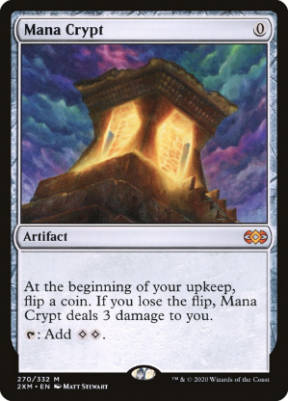
Mana Crypt is the epitome of a powerful artifact. Much like Sol Ring, it is powerful enough to be banned in Legacy, Restricted in Vintage, and see play in nearly 200,000 EDH decks according to edhrec.com. It cost nothing at all to cast and it taps for two colorless mana.
However, you do have to flip a coin at the start of each of your turns and risk-taking three damage. But ask yourself this question – Would you take three damage a turn for two free mana a turn? The answer here is almost always going to be yes. Especially in a format like commander where players have 40 life.
What’s better is that the scenario mentioned above is the worst-case scenario. If you lost every coin flip the card would probably still be worth it and chances are there will be quite a few turns where you’ll win and take no damage at all.
The fact that Mana Crypt comes down on turn one (in addition to your land for turn) and gives you two mana often puts you so far ahead that you stand to close out games long before that pesky three damage catches up to you.
Walking Ballista

Walking Ballista is a beast of a card and one I am never happy to see across the table from me. It has so many things going for it and a ton of versatility as well. First, its “x” casting cost makes it a best friend of big mana decks.
Things like Tron for example, can funnel copious amounts of mana into a ballista and have a huge threat. It’s also possible to turn a Ballista into an absolute beater with cards like Hardened Scales that double up the number of counters you put on it.
What really makes it a powerhouse though is its last ability. By simply removing a counter from it you can deal one damage to whatever you’d like. The fact that there is no activation cost beyond removing the counter means that all of the counters can be removed at any given time. Why is this so incredibly good?
Well first, the counters can be emptied off in response to removal. So, killing a Walking Ballista means you’re going to take damage equal to its power one way or another. This makes it resilient, a possible removal spell (if it targets your creatures), and/or a burn spell.
Secondly, this ability essentially doubles the Ballista’s power in a lot of cases. For example, a 3/3 Ballista can attack and deal three damage to a player or creature that blocks it and then remove all three counters and deal three more. This is huge for getting through extra damage or taking out larger blockers.
Lastly, the ability enables many infinite combos that can win you the game on the spot. The main way this happens is by generating infinite mana and then using Walking Ballista to turn it into infinite damage. One common way of doing so is with Devoted Druid and Vizier of Remedies. Here’s a very quick look at how it works.
You tap the Devoted Druid for mana, then untap it. When you do Vizier of Remidies doesn’t allow the -1/-1 counter to go onto the Druid. So, you can then tap and untap the Druid to make infinite green mana.
Recommended Formats: Modern, Legacy, Vintage, Commander
The “Sword Of” Cards
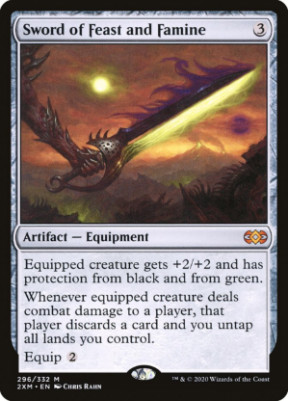
The “Sword of” cards are all extremely powerful cards. As a result, I gave them a spot as a whole considering they are all great and do similar things. First, let’s take a look at each of the Swords, and then we can break down what makes them so strong.
- Sword of Feast and Famine
- Sword of Fire and Ice
- Sword of Body and Mind
- Sword of Hearth and Home
- Sword of Light and Shadow
- Sword of Sinew and Steel
Each card in the “Sword of” cycle offers your a similar effect. The creature it’s equipped to will +2/+2 bonus, protection from two colors, and two powerful effects that trigger when it does combat damage. For only three-mana and two to equip, each Sword offers value at a great rate.
Furthermore, the protection from two colors means the swords are extremely good at getting around possible blockers and triggering themselves. With that said, the +2/+2 boost turns even small creatures into threats.
What you get when you do deal combat damage varies from sword to sword. However, all of them are very strong in the right decks and situations. And protection from two colors can often nearly win you the game all by itself.
Pairing the Swords with cards like Puresteel Paladin, Steelshaper’s Gift, Sigarda’s Aid, and Stoneforge Mystic makes these alreay great artifacts that much more powerful and any one of them can pose a game winning threat.
Baleful Strix
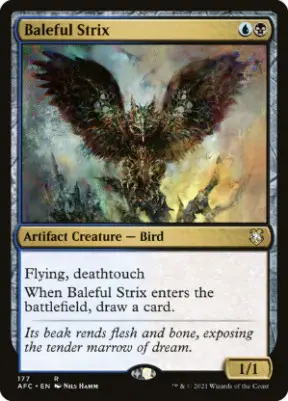
Baleful Strix isn’t flashy but make no mistake about it, it is a very good card. It sees a ton of play in Legacy and Commander alike, and with very good reason. For a two-mana investment, you get a 1/1 flier with deathtouch, that draws you a card when it enters the battlefield.
You’ll always have gotten your money’s worth as soon as it enters the battlefield. This means that it is a very expendable blocker both in the air and on the ground, that can trade with much bigger threats thanks to its deathtouch.
It’s also a great target for spells like Flickerwisp that can reset it and give you even more value. If you’re in Dimir in EDH or looking to build control decks in Legacy, this is an artifact that you should almost always be running.
End Step
Artifacts are a very diverse, very powerful card type in Magic: The Gathering. Some are creatures and others are lands. With that said, not only are the cards themselves often good but there are tons of incredible payoffs for running a deck full of them. Now that you know what they are, how they work and some of the best in print get out there in your favorite format and sleeve up some.

